Introduction
Whether you love cooking and entertaining or not, your sink and taps are some of the most hard-working fixtures of your kitchen.
And because you know you will be using them daily, it is important to choose the best quality that you can afford.
There is a very big selection on the market and a big part of your decision will be determined by both style and price. But there are also other aspects to consider when it comes to choosing the right taps and sink for your kitchen.
This book will guide you through all the things you need to consider.

Click Through To Specific Sections
Sinks
1. Sinks – Assessing Your Needs

To choose the right sink for your kitchen, you will first need to determine what exactly your needs are.
Ask yourself these questions:
- Do you cook daily?
- What is the size of your family?
- Do you entertain regularly?
- Do you have a kitchen garden or often cook with fresh ingredients?
- What are the sizes of your oven dishes, pots and casseroles?
- Do you have a dishwasher?
An avid cook will most certainly require a large double sink for soaking roasting trays and dishes, while a convenience cook will need a smaller sink area. If you have a dishwasher to take care of the place settings and glasses, then a fixed drip tray might not be a necessity.
Fresh ingredients might require a prep bowl close to the main work surface, while regular entertaining will warrant a waste
disposal.
2. Sink Styles
There are 3 basic sink styles to choose from, and it mainly refers to the method of installation:
Under Mount

The sink is installed underneath the countertop. This style is not suited to postform tops where the edge will be exposed to water.
Top Mount

Also called countersunk, the sink is dropped into a hole cut in the counter top.
Integrated

This is a seamless, custom sink that is fully integrated with the countertop. Suitable for solid surfacing, quartz and stone tops.
3. Sink Materials
The variety of sink materials available is big enough that you are certain to find something that fits your style and pocket.
Stainless Steel

A basic, hard-wearing and very trendy option, stainless steel sinks come in a large variety of shapes and sizes. They are great for both industrial and contemporary kitchens. Since stainless steel is completely non-porous, they are ultra hygienic and very easy to keep clean.
These sinks can be both under mount and top mount. They are especially suited to home-owners who tend to be a bit harder on their sinks. If you are in the habit of throwing things down, this is the sink for you!
Sound absorption technology prevents the modern stainless steel sinks from being as noisy as their older counterparts.
They come in both mirror and satin finishes, the latter being more forgiving in terms of scratches and water stains. 16 gauge stainless steel is a better quality, although 18-gauge is also suitable.
Enamel-coated Cast Iron
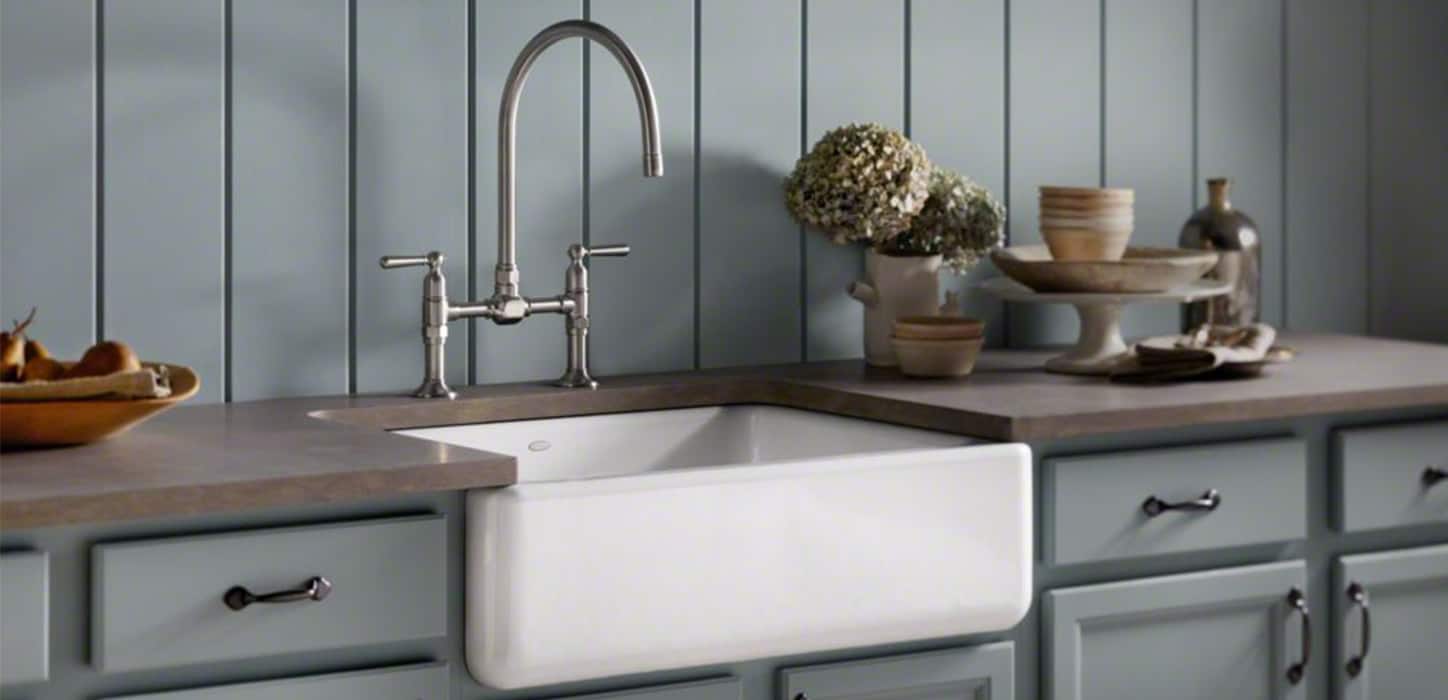
A more traditional option that is most often used in country kitchens as butler sinks.
It is made of a durable iron alloy with a porcelain enamel coating, fired at extremely high temperatures resulting in a beautifully smooth and glossy finish.
These sinks are extremely durable, but can chip or scratch if they are not handled with some care. Avoid using strong or abrasive cleaners as these may damage the coating.
The weight of the sink will require additional supports for mounting.
Composite Sinks
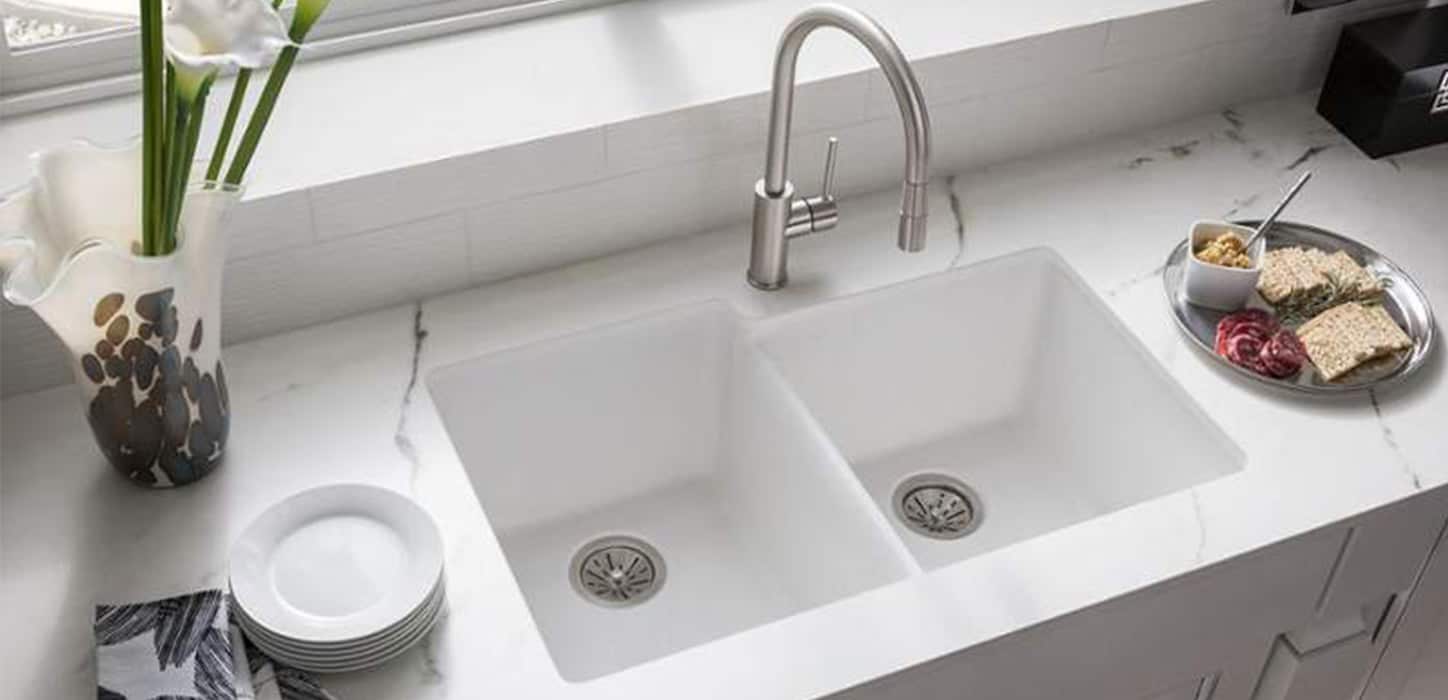
A lot of modern sinks are being made from composite materials like quartz and granite fused with polyester or acrylic resins.
The higher the stone content, the higher durability the sink will have. Granite is the most durable option with quartz being a close second.
Because the material can be moulded, the design capabilities both in terms of style and colour are endless. These sinks can also be seamlessly integrated with a countertop of the same material.
Composite sinks are highly heat and scratch resistant, making them extremely durable. Look for products that have antibacterial properties, ensuring a more hygienic sink.
Fired Clay

A robust and easy to clean option, it is made with ceramic clay that has been fired at extreme temperatures which fuses the glaze to its surface.
This is a more traditional style of sink, but because of its durability and undermount ability, it is a popular choice for contemporary kitchens as well.
While it is a durable surface, care should be taken with heavy pots and pans to avoid the surface chipping. It is also advisable to not throw items into the sink which may damage the surface.
Ceramic sinks are easy to clean and the glaze is non-porous which also make them resistant to bacteria.
Stone
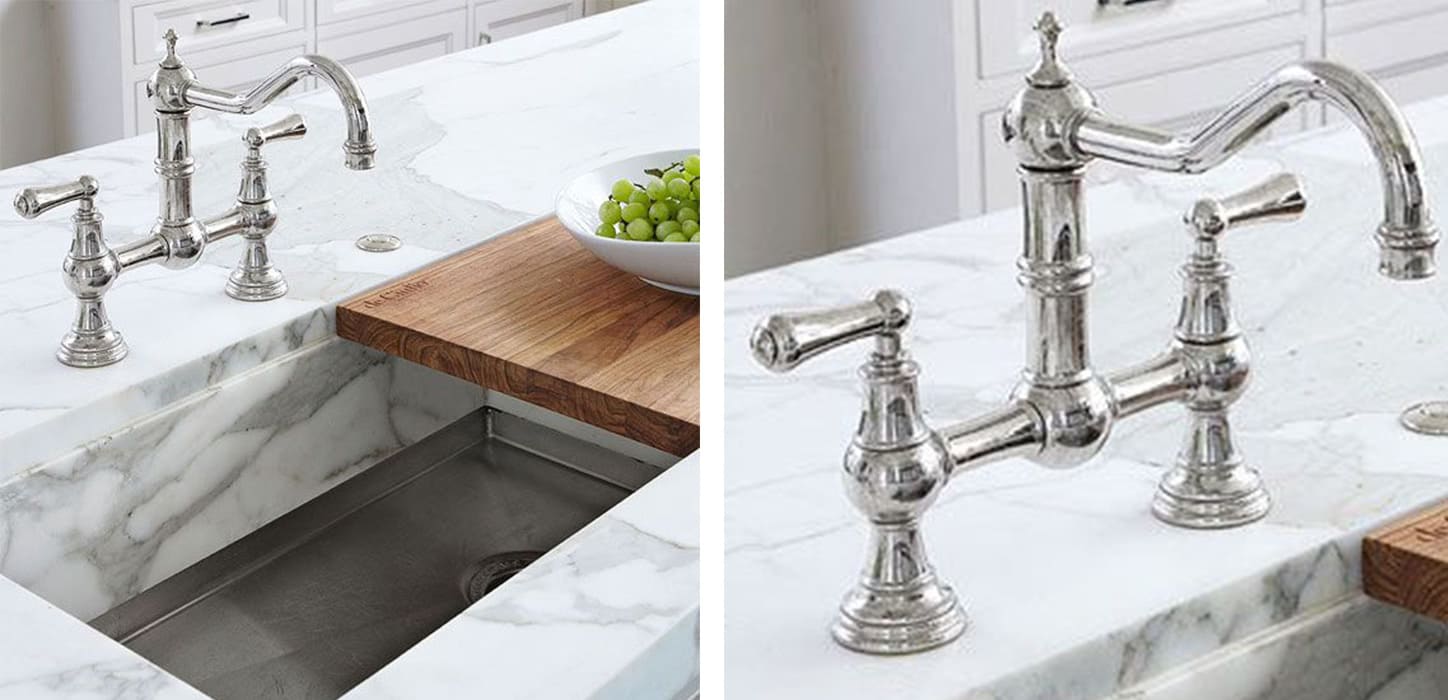
Stone sinks are a very popular and trendy choice that create a seamless look in your kitchen.
Because the stone panels are bonded to create the sink, the sinks have the tendency to have sharp corners which may be difficult to keep clean.
They are however extremely durable and beautiful.
Solid Surfacing

This material allows the sink to be completely seamless and is one of the most hygienic options available. Because of its total integration into the countertop, there are no joins or nooks and crannies that may harbour bacteria.
Solid surfacing is extremely durable and heat, scratch and stain resistant. Damage can also be easily repaired.
Because it’s a manufactured material, the design options are vast.
TIP
Make certain that your cabinet will fit your new sink. A standard 600mm deep cabinet should be fine for most models, but some sinks require a deeper cabinet, even up to 1000mm.
Size and Shape
Once you are happy with your material choice, you will need to consider the size and shape.
Single Bowl

These come in a variety of sizes, from a tiny sink suitable to a small kitchen to a large and deep unit that can easily accommodate large dishes.
Prep Bowl

A small sink in the main area of the kitchen when a full scullery is available for washing and prepping of larger items.
Double Bowl

This option comes in a variety of combinations, from 2 different sized bowls to 2 equal sides with varying depths. This makes washing up easy and allows for prepping while taking care of dishes or other washing tasks.
Triple Bowl

A small central sink allows for rinsing of smaller items or vegetables. This is often also where the waste disposal unit would be installed.
Butler Skins

Large, rectangular sinks that come as either London (shallow) or Belfast sinks with a weir overflow. Traditionally they only have 1 bowl, but modern versions come in a variety of configurations.
5. Added Features

Waste Disposal:
A grinding mechanism that liquefies food waste before being disposed with the waste water.
Water Filtration System:
A filtering system connected to an under-counter water tank that supplies filtered water through a separate faucet.
Hot Water System:
Another separate under-counter tank that dispenses filtered, near-boiling water.
Colanders and Baskets:
Removable baskets and colanders that fit perfectly into the sink, allowing for easy rinsing of food or for drip-drying dishes.
Cutting Boards:
Many sinks come with an integrated cutting board, allowing for additional counter space when the sink is not being used.
Integrated Drip Tray:
Grooves cut into a side panel, allowing for water to run back into the sink while drip-drying dishes.
Taps – What To Look Out For

Taps are not only a very visual part of your kitchen hardware, it is also something that you will be using very often. Here are a few points to consider when choosing your new taps:
- Water Pressure
- Functionality
- Installation
- Handles
- Style
- Materials
1. Water Pressure

A very important consideration when choosing taps, is the water pressure it requires to function optimally.
TIP
Ask your plumber to confirm your water pressure before you start looking for your new taps.
2. Functionality

As with the other fixtures in your kitchen, consider first how exactly you’ll be using the different taps in the room:
Hot, cold or both?
You don’t necessarily need both hot and cold water in every area. If you are only ever going to rinse veggies at your prep bowl, you might only need a cold water tap.
Lever or turn?
Aesthetics aside, how would you prefer to switch the tap on: by lifting a lever or by turning the handle? Most levers allow for a single control of both the hot and cold tap through a mixer, while turn handles gives you individual control through either a mixer or 2 separate taps.
Spray nozzle, aerated or extendable?
What the tap is used for will determine how the water is dispensed. If it’s to rinse plates before placing them in the dishwasher, then an extendable spray nozzle is very handy. If it’s used for food prepping, then an aerated head assists with water conservation.
3. Installation
Taps can be installed in a few different ways. The design of the sink that you are considering as well as the countertop material will determine how your taps can be installed.
Counter top

The taps are installed directly onto the countertop, behind the sink. Holes are cut or drilled through the top and sufficient water proofing added around the hole to prevent water from getting into the area below.
Wall

Taps can also be installed directly onto the wall behind the sink. A suitable wall finish like tiles will be necessary behind the taps to prevent water damage to the wall.
Sink

Some sinks come with integrated holes to allow for the installation of taps directly onto it.
4. Tap Handles
There are 3 main types of tap handles:
Knob

A traditional tap handles comprising a metal, porcelain or acrylic knob for controlling water flow.
Cross Head
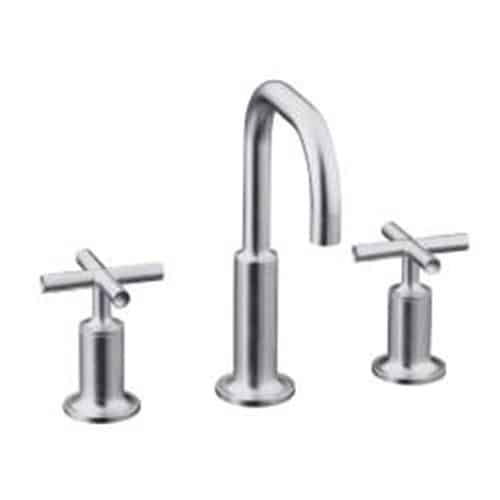
The handle looks like a cross to enable a good grip and ease of use.
Lever

A single or double lever is lifted to control the flow of water.
5. Tap Styles
Water dispensing and the way in which the hot and cold water flow is controlled, determine the type of tap unit.
Pillar Taps

Comprising 2 separate taps, one for hot and one for cold water. Featuring knob, cross head or lever handles, these tend to be used with a more traditional installation like a butler sink.
Monobloc Taps

This type of tap features a single spout fed from 2 connecting handles which can be in a knob, cross head or lever style. This is the most commonly used tap because of its functionality and space-saving features and because installation requires 1 hole.
Mixer Taps

2 separate taps for controlling the hot and cold water feeding through to a single spout, thereby mixing it. Available in knob, cross head or level style.
Single Lever Taps
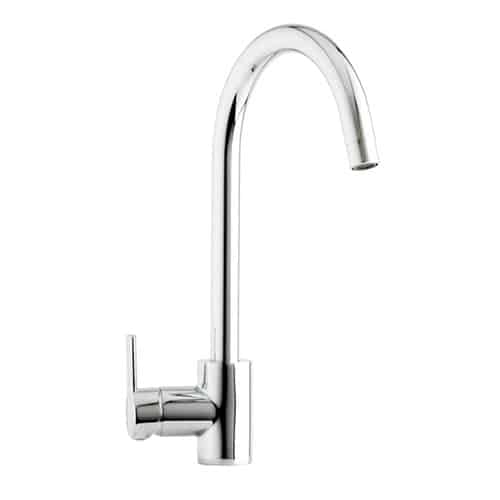
A minimalist option where a single lever controls both heat and flow of water.
Extendable Spray

An industrial kitchen fixture that found its way into the domestic kitchen, this tap boasts a flexible pipe that allows the user to spray water where directed.
Automatic Taps

These intuitive taps work with a sensor to control the flow of water, allowing for hands-free operation.
6. Tap Materials
Taps are made using a large variety of materials, and the choice is mostly going to come down to aesthetics. Here are 4 of the most popular materials.
Stainless Steel

An alloy that is corrosion-, tarnish- and scratch resistant.
Chrome

Metal core with a thin chromium veneer, it mostly comes in a polished or mirror finish.
Nickel

Metal core with a thin nickel veneer, it comes in a polished, brushed or darker antiqued finish. It is often lacquered to prevent tarnishing over time.
Brass

The perfect choice for a traditional or industrial kitchen, warm brass has a beautiful polished or matte finish that wears very well over time.
About Product Warranties

The cost of taps and sinks can vary greatly and as with any home fixture it is important to buy the best you can afford. Here are few things to note:
Manufacturers will guarantee their products for anything from 3 to 10 years for taps, and up to 25 years for sinks. Some manufacturers even offer a limited lifetime warranty on their taps.
Unless you plan to sell your property, consider the replacement costs of your taps and sinks if you choose a product with a 3 year warranty. To ensure long and uninterrupted use of your new fixtures, opt for products with a longer warranty attached and ensure proper installation and use.
TIP
Don’t cut corners when it comes to your tap budget. A cheaper product causing water damage could cost you dearly in the long run.
Contact Us
Call us on: 01 230 0336
Dun Laoghaire
129 Oliver Plunkett Road Dun Laoghaire
Dublin

